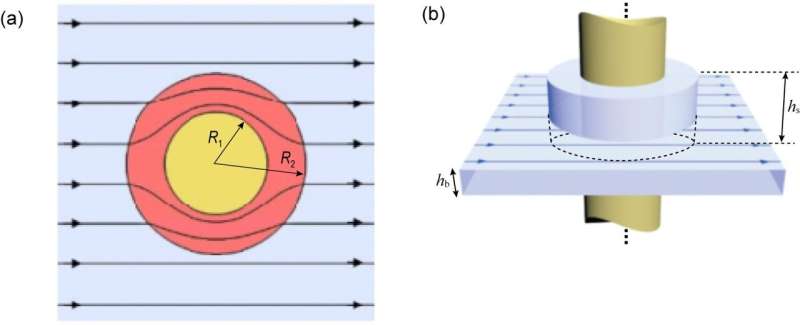a. The fluid-flow cloak guides streamlines smoothly around a cylindrical obstacle; b. The fluid-flow cloak is realized by making the thickness of the fluid channel thicker closer to the obstacle and thinner farther from it. Credit: Science China Press
The invisibility cloak is an artifact that can make the wearer transparent, rendering it undetectable to observers outside. Perhaps, one of the most well-known examples is the invisibility cloak possessed by Harry Potter who used it to great the success in the second wizarding war. For centuries, such a magic device has existed only in science fictions. The recent development of the metamaterial technology provides a possible route to implement the invisibility cloak in reality.
The concept of the metamaterial invisibility cloak was first introduced by Sir John Pendry and coworkers in 2006. Since then, researchers have tried to implement different versions of invisibility cloaks. There are optical cloaks which can make the object transparent for visible light. There are radar cloaks which can render the object undetectable from radar detection. There are also acoustic cloaks which can make the object invisible for sound. All the cloaks experimentally realized thus far reply on metamaterials, which are artificially structured building blocks with judiciously designed unit cells. The unit cells serve as artificial atoms of the metamaterial. With a proper design, they can control the speed of light or sound at will, a property critical for cloak engineering. Moreover, the metamaterial concept can even be extended to fluid dynamics to control fluid flow. Nevertheless, the fabrication of metamaterial unit cells generally involves complex micro or nanofabrication, making the implementation of the large-scale invisibility cloak difficult.
In the recent issue of National Science Review, the research team led by Prof Baile Zhang from the school of physical and mathematical sciences, in collaboration with Prof Yu Luo from the school of electrical and electronic engineering at Nanyang Technological University, published a paper entitled "A Metamaterial-Free Fluid-Flow Cloak." It aims at realizing a simplified version of the large-scale invisibility cloak without using any metamaterials.
Video 1. Left panel: fluid flow in homogeneous fluid channel; middle panel: fluid flow around a bare cylindrical obstacle; right panel: fluid flow around the obstacle covered by the cloak. Credit: Science China Press
The team considers a special type of invisibility cloaks in ideal fluid flow. Without any obstacle, the fluid flows along a straight line similar to light propagating in vacuum. Once the obstacle is present, the straight streamline will be defected and spread over the whole space. By detecting the distortions of the streamlines, an observer outside is able to sense the size, shape, and position of the obstacle. A fluid-flow cloak seeks to conceal such distortions and restore original straight streamlines. It controls the speed of the fluid flow, guiding the fluid to flow faster closer to the obstacle and slower farther from it. In such a way, the fluid, once passing through the obstacle, returns to the original path and continues to flow along a straight line as if the obstacle is not there. According to Bernoulli equation, the speed of the fluid flow is inversely proportional to the square root of the mass density of the fluid. In other words, to control the speed of the fluid flow requires one to judiciously engineer the mass density of the fluid. To this end, traditional approaches generally rely on complex metamaterials.
The team tackled this problem from a different perspective. They found an alternative way to control the mass density of the fluid by simply engineering the thickness of the fluid channel. They showed that thicker fluid channel gives rise to smaller mass density, where the fluid flows faster. Hence, a large-scale invisibility cloak can be implemented by simply making the fluid channel thicker closer to the obstacle and thinner farther from it. To demonstrate the cloak effect, the team recorded the fluid dynamics in real time and compared the fluid flows for three cases. In a realeased video, the reference case on the left panel shows that the fluid flows along a straight path in a homogeneous channel. The middle panel corresponds to the case where the streamlines are deflected by a bare obstacle. The cloak case on the right panel illustrates how the fluid flow is smoothly guided around the obstacle and returns to the original path without deflection. The straight streamlines outside the cloak remain similar to those of the reference case.
The team's research not only provides a powerful platform to implement large-scale fluid-flow cloaks, but also has far-reaching impacts for fluid control in microfluid channels.
More information: Fuyang Tay et al, A Metamaterial-Free Fluid-Flow Cloak, National Science Review (2021). DOI: 10.1093/nsr/nwab205
Provided by Science China Press
























